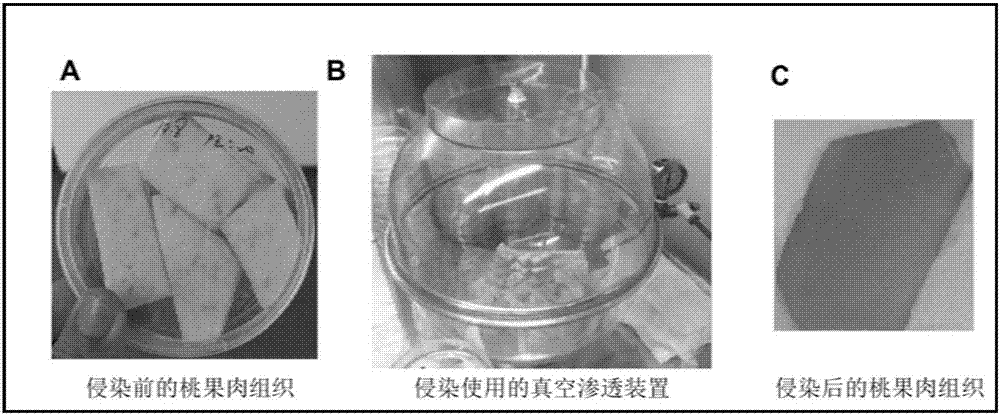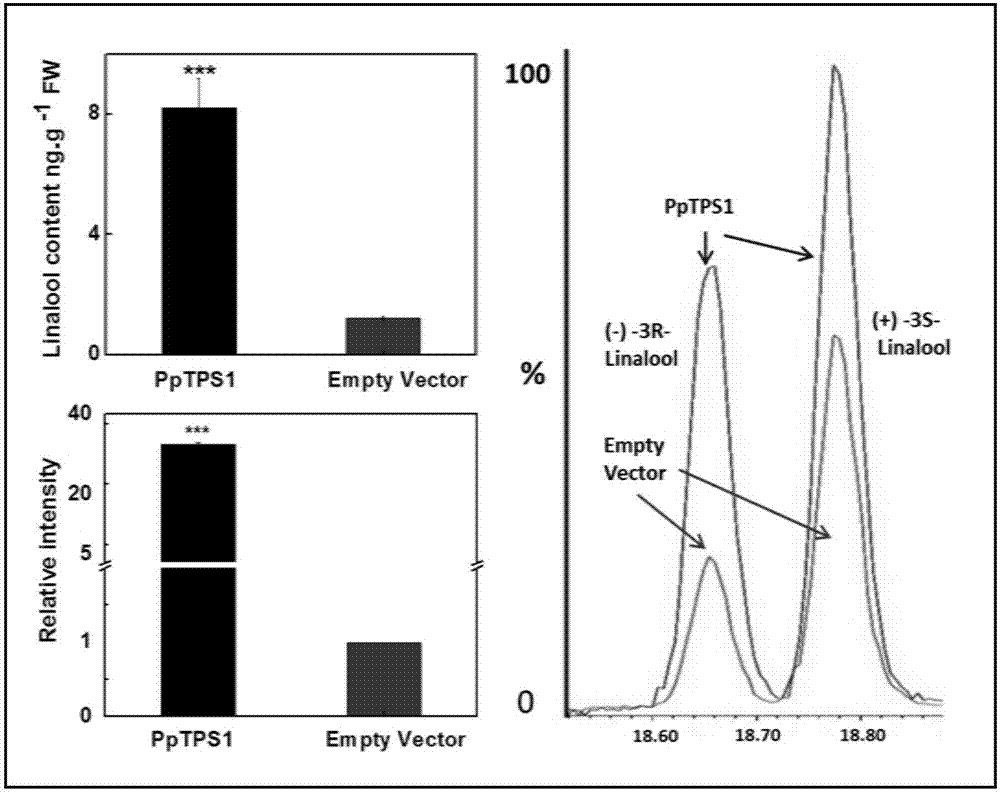Method for realizing gene transient expression in peach fruits
A transient expression and fruit technology, applied in genetic engineering, biochemical equipment and methods, using vectors to introduce foreign genetic material, etc., can solve the problems of lack of regeneration system and transgenic technology, etc., achieve reliable results, high expression level, and simple operation Effect
- Summary
- Abstract
- Description
- Claims
- Application Information
AI Technical Summary
Problems solved by technology
Method used
Image
Examples
Embodiment 1
[0025] The present invention will be further described below in conjunction with specific embodiments and accompanying drawings, but the embodiments do not limit the protection scope of the present invention. Embodiment 1: Cloning of peach fruit PpTPS1 gene (SEQ: NO.1)
[0026] (1) Experimental method
[0027] Taking the amino acid sequence of AtTPS14, which has the function of linalool synthesis in Arabidopsis thaliana, as a reference sequence, the blastp algorithm was used to search for peach homologous sequences in the peach genome database Peach Genome V2.0. Select the sequence with the highest matching degree, design primer pair SEQ:NO.2 and SEQ:NO.3, use peach cDNA as template, carry out PCR amplification to obtain the sequence numbered as Prupe.4G030400 (SEQ:NO.1), named as PpTPS1. The PCR reaction system was 50 μl, including 0.5 μl Taq enzyme (Roche), 5 μl buffer (10×), 4 μl dNTP (2.5 mM), 2 μl each of upstream and downstream primers (10 μM, Invitrogen), 4 μl cDNA, 3...
Embodiment 2
[0030] Example 2: Transient expression of PpTPS1 in the fruit of 'Zhonghua Shoutao' promotes the synthesis of aroma substance linalool
[0031] (1) Experimental method
[0032] 1. Agrobacterium transformation culture containing the target gene PpTPS1
[0033] The target gene is constructed on the plant binary expression vector PGreen0029 62-SK, the primers used in PCR are aligned to SEQ: NO.4 and SEQ: NO.5, and the PCR product is connected to the vector by double enzyme digestion, and the enzyme digestion site is BamHI and SalI were transformed into Escherichia coli, cultured overnight, single clones were picked and sequenced for verification, and then the recombinant plasmid was electrotransformed into Agrobacterium GV3101::pSoup. After culturing in solid medium containing kanamycin (50mg / L) and gentamycin (50mg / L) at 28°C for 2 days, select monoclonal strains, add 5ml of LB containing kanamycin and gentamicin antibiotics after PCR test middle. After overnight culture, exp...
Embodiment 3
[0049] Embodiment 3: Cloning of peach fruit PpTPS2 gene (SEQ: NO.13)
[0050] (1) Experimental method
[0051] Taking the apple MdAFS-RG1 sequence with the function of α-Farnesene synthesis as a reference sequence, the blastp algorithm was used to search for homologous sequences in the peach genome database Peach Genome V2.0, and the sequence with the highest matching degree was selected. SEQ: NO.11 and SEQ: NO.12. The PpTPS2 sequence SEQ: NO.13 obtained by PCR amplification was verified by sequencing. The PCR system is the same as in Example 1.
[0052] (2) Experimental results
[0053] After sequencing verification, the PpTPS2 sequence SEQ: NO.13 matching the peach fruit genome data was obtained
PUM
 Login to View More
Login to View More Abstract
Description
Claims
Application Information
 Login to View More
Login to View More - R&D
- Intellectual Property
- Life Sciences
- Materials
- Tech Scout
- Unparalleled Data Quality
- Higher Quality Content
- 60% Fewer Hallucinations
Browse by: Latest US Patents, China's latest patents, Technical Efficacy Thesaurus, Application Domain, Technology Topic, Popular Technical Reports.
© 2025 PatSnap. All rights reserved.Legal|Privacy policy|Modern Slavery Act Transparency Statement|Sitemap|About US| Contact US: help@patsnap.com



